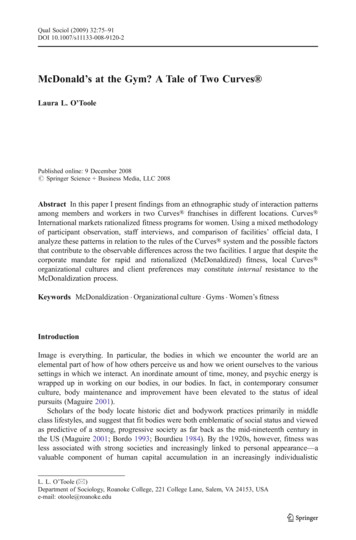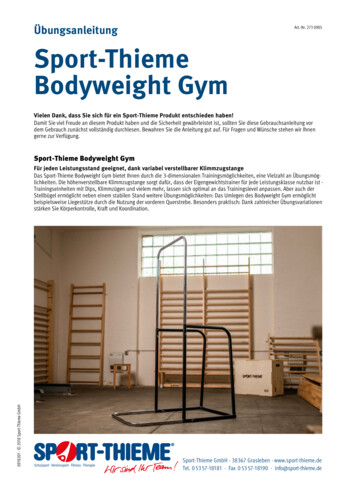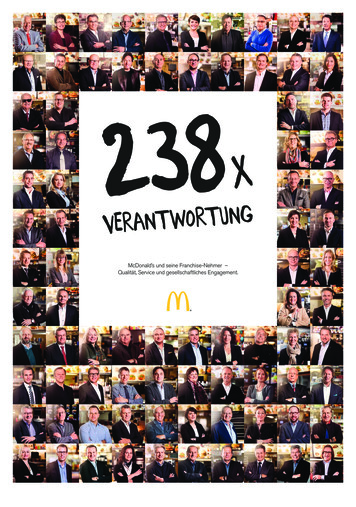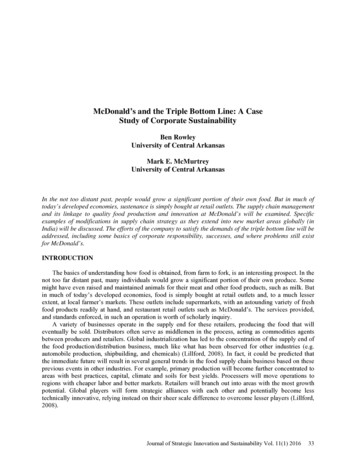
Transcription
Qual Sociol (2009) 32:75–91DOI 10.1007/s11133-008-9120-2McDonald’s at the Gym? A Tale of Two Curves Laura L. O’ToolePublished online: 9 December 2008# Springer Science Business Media, LLC 2008Abstract In this paper I present findings from an ethnographic study of interaction patternsamong members and workers in two Curves franchises in different locations. Curves International markets rationalized fitness programs for women. Using a mixed methodologyof participant observation, staff interviews, and comparison of facilities’ official data, Ianalyze these patterns in relation to the rules of the Curves system and the possible factorsthat contribute to the observable differences across the two facilities. I argue that despite thecorporate mandate for rapid and rationalized (McDonaldized) fitness, local Curves organizational cultures and client preferences may constitute internal resistance to theMcDonaldization process.Keywords McDonaldization . Organizational culture . Gyms . Women’s fitnessIntroductionImage is everything. In particular, the bodies in which we encounter the world are anelemental part of how of how others perceive us and how we orient ourselves to the varioussettings in which we interact. An inordinate amount of time, money, and psychic energy iswrapped up in working on our bodies, in our bodies. In fact, in contemporary consumerculture, body maintenance and improvement have been elevated to the status of idealpursuits (Maguire 2001).Scholars of the body locate historic diet and bodywork practices primarily in middleclass lifestyles, and suggest that fit bodies were both emblematic of social status and viewedas predictive of a strong, progressive society as far back as the mid-nineteenth century inthe US (Maguire 2001; Bordo 1993; Bourdieu 1984). By the 1920s, however, fitness wasless associated with strong societies and increasingly linked to personal appearance—avaluable component of human capital accumulation in an increasingly individualisticL. L. O’Toole (*)Department of Sociology, Roanoke College, 221 College Lane, Salem, VA 24153, USAe-mail: otoole@roanoke.edu
76Qual Sociol (2009) 32:75–91society characterized by a competitive market economy. For women, the equation of thefemale form with beauty and sexual excitation during the early twentieth century projectedthe achievement of physical attractiveness as a route to “passive power” (MacNevin 2003,p. 273), presumably within the marriage market.Concepts of fitness and standards for female beauty have increasingly converged in theconsumer culture of the late twentieth and early twenty-first centuries (MacNevin 2003).From a sociology of bodies perspective, one major and compelling social force in the latetwentieth century is assuredly the concomitant development of increasingly mammoth“appearance industries,” including cosmetics, dieting, and more recently a commercialfitness industry (Maguire 2001) all linked to normative standards for women’s appearance.For women, the pressure to measure up favorably against specific ideal standards offeminine beauty fuels both personal and collective insecurities and corporate engines.While historical notions of fit bodies as instruments of personal and societal progress areapplicable to both men and women, feminist research in the 1980s and 1990s focused onthe constraining power of beauty myths and the extent to which various forces in consumerculture elicit the complicity of women in the project of constructing ideal bodies (Bordo1993; Wolf 1990). With changing gender role constructions, women’s fitness is construedas highly significant to their achievement in the labor market as much as it is in the pursuitof personal relationships; yet, much of this emphasis on body construction has beencritiqued as unhealthy for women—both physically and psychologically. More recentresearch, however, suggests that although twentieth century beauty norms for women weremore superficially linked to accomplishments in relation to the “surface of the body,”women’s contemporary body projects are more likely to conflate beauty with health,blurring boundaries of internal and external bodily concerns into a holistic concept offitness (MacNevin 2003).Since the late 1990s, a particularly phenomenal development in the area of women’s healthand fitness has been the establishment and ubiquity of women-only gyms and fitness centers.The niche leader in this area is Curves for Women, now an internationally franchisedoperation. Indeed, at this writing, Curves International is the largest fitness franchise in theworld, focused simultaneously on the culturally defined fitness needs of women and addressingthese needs in a fully rationalized manner that is consistent with contemporary lifestyles andwomen’s dual, time-consuming roles as workers and family caretakers.In sociological parlance, Curves can be understood as “McDonaldized” fitness. Ritzer(2004) defines McDonaldization as “the process by which the principles of the fast-foodrestaurant are coming to dominate more and more sectors of American society as well asthe rest of the world (p. 1),” a predominant force that characterizes twentieth and twentyfirst century institutional development. An extension of Weber’s theory of rationalization(Freund 1968), the McDonaldization thesis specifies efficiency, calculability, predictability,and control through non-human technology as the predominant features of socialorganization in formal organizations and everyday life practices (Ritzer 2004, pp. 12–15).This study is a tale of two Curves among the many; a comparative analysis of thecharacteristics of two quite different Curves franchise operations in the Southeast US.Specifically, I situate these franchises within an analysis that utilizes both local communitycharacteristics and the internal organizational cultures of the gyms themselves to shed lighton the durability of McDonaldization. I observe patterns of interaction among members andworkers at the two facilities and analyze these patterns in relation to the normativeexpectations of the Curves system and the relative “success” of the two franchises. In sodoing, I explore the possible factors that contribute to the observable differences inachieving prototypical McDonalization across the two facilities.
Qual Sociol (2009) 32:75–9177Sassatelli (1999) suggests that “the way gyms are organized—both their environmentand the interaction rules operating during training—is as important for clients as theculturally shaped ideals which sustain fitness culture” (p. 1). Using the Snow et al. (2003)prescription for analytic ethnography as a significant route to extension and refinement oftheory, I deploy my data to extend Ritzer’s conceptualization through integratingSassatelli’s (1999) evidence that localized cultures matter. The significance of localadaptations of Curves’ normative culture can contribute to our understanding of concrete,human responses to the McDonaldization phenomenon, particularly within an organizationpredicated simultaneously on the promise of a supportive internal community.In light of its widespread institutionalization, resistance to McDonaldization is typicallycharacterized as subversive individual choice or as situated in alternative organizations andservices that often exhibit a social movement orientation such as Slow Food organizationsand cooperatives that originated in Italy and have spread throughout Europe and into theUS (Miele and Murdoch 2002; Ritzer 2004). Similarly, Ritzer’s (2004) analysis infers thatthe persistence of Mom and Pop stores and non-chain establishments in the face ofwidespread McDonaldization and Starbuckization is evidence of resistance, but that suchestablishments are at considerable risk of being co-opted. I argue that despite the corporatemandate for rapid and rationalized fitness, local Curves’ organizational cultures and clientpreferences may constitute internal resistance to the McDonaldization process.The gym and human experienceGyms and fitness centers provide unique scenarios for understanding both personal andcollective experiences of bodywork, community norms, and organizational cultures.Waquant (2004), for example, describes the inner-city gym where he conducted an indepth ethnographic immersion variously as a sanctuary, a school of morality, and the locusand support of “pure sociation” for members (pp. 14–15, 37). Bodies and souls of youngmen are transformed simultaneously through the intense regimen of training for and thepractice of boxing, as well as the collegiality of the gym community. In this case, thesocializing power of the gym, which Wacquant (2004) likens to a conversion experience,can be linked both to the respite it provides from the streets and the sheer amount of timeparticipants dedicate to their individual and collective training in the “manly art”.Smythe (1995) analyzes stories of embodiment shared among women in a predominantly female gym she calls Bodyworks that reflect impression management ritualsassociated with meanings of true membership. Multiple themes of empowerment throughexercise complement the primary finding that Bodyworks women are deeply focused upontheir “essential corporality” (p. 13) and that true members work very hard on their bodies.Localized norms and shared sentiments sustain interpersonal relationships and loyalty to theclub. Smythe also identifies an ideology shared more generally by members of fitnesscommunities: that effort and persistence are powerful predictors of success in overcomingoverindulgence, age-related, and even hereditary conditions that may disrupt the profferingof a socially desirable self (Smythe 1995, p. 10).Craig and Liberti (2007) analyze the organizational culture of a chain of women-onlyfitness centers, outlining the social processes that function to feminize the gym. The setting,routine, and intentional corporate discourse in numerous locations of GetFit are shown toconstruct a comfortable environment for the subset of women who were formerly leastlikely to either exercise or, particularly, to join a gym for this purpose. In a non-competitivesetting where large and/or aging women are socially constructed as normal, where
78Qual Sociol (2009) 32:75–91heteronormativity dominates discourse, and where circuit-based labor processes andtechnologies shape experience, the GetFit image of femininity sustains traditional genderhierarchies (Craig and Liberti 2007, p. 697). Here the focus is on weight loss, rather thanthe physical exertion and masculinized fitness norms that dominate in more traditionalgyms. Informants did not report women trying to “distinguish themselves from othersthrough demonstrations of greater physical fitness” (Craig and Liberti 2007, p. 682). Thesefindings, insofar as they are contrasted to the emphasis on exertion and empowerment in thestories analyzed by Smythe, lend credence to the significance of local normative practicesand discourses in shaping differentiated human experience.Sassatelli (1999) uses frame analysis to compare local environments and interactionpatterns in two gyms to determine the extent to which members are socialized to persist in afitness regimen (p. 2). Gym environments exhibit complexity and variation in terms of thespatial organization of training and changing areas, the modes of training equipment andadvice available, and the facility with which individuals can realize personal fitnessobjectives. Sassatelli (1999) distinguishes between procedural and substantive aspects ofthe gyms to discern that body ideals represent only a small part of the meanings created inthem (p. 5). Successful framing involves both affective and instrumental dimensions; clientsare more likely to persist when both objective goals and expressive needs are met—whenexercise is not only productive in relation to personal fitness, but also fun.Taken together, these studies provide significant scaffolding for my analysis of howwomen’s agency mediates the Curves normative culture. Participant observation in gymsand fitness centers has produced clear evidence of the influence of localized rituals,discourses, and support systems in producing both individual responses to bodywork anddiscernable organizational cultures. The extent to which substantive (McDonaldized)concerns are integrated with the affective needs of members in particular franchiseoperations, as well as the demographics of club members and communities providesignificant clues to the variety of cultural experiences one might encounter when workingout at Curves , corporate models notwithstanding.The Curves story: Rationalizing fitnessThe first Curves opened in Harlingen, TX, USA in 1992; its original marketing strategy was totarget “small town USA,” where fitness opportunities for women were lacking. The system wasfirst franchised in 1995; by 2005 there were over 9,000 facilities on five continents, ademonstrably rapid growth over the 10-year period (Canfield 2004). From its initial small townorigins, Curves’ rapid expansion has included the infiltration of urban centers. In Illinois, forexample, half of the 350 Curves franchises are in the Chicago area and the rest are scatteredacross the downstate. In the US, one in every four fitness clubs is a Curves (Canfield 2004).Curves promotes itself as “the first fitness and weight loss facility dedicated to providingaffordable, one-stop exercise and nutritional information for women” (Curves International2005). The primary product is a 30 minute workout routine, completed on eight to 12machines separated by “recovery squares,” and designed to accomplish both aerobic exerciseand strength training for every muscle group. It is designed to be “fast, fun and safe.” Indeed,Gary Heavin, the founder of Curves International, legitimates the sociological conceptualization I offer above: “We are the McDonald’s of fitness centers in the US and Canada and wecan be the McDonald’s of fitness centers around the world” (Canfield 2004). The fullyrationalized workout routine—“the circuit”—is taught to women, by women, and promisesboth weight and inch loss when practiced at least three times per week in conjunction with a
Qual Sociol (2009) 32:75–9179healthy diet. The standardized conceptualization of Curves notwithstanding, a centralstrategy was to offer this “30 minute fitness and common sense weight loss [program] withthe support of a community of women” (Curves International 2005). The Curves “comfortzone” is typically situated within a no-frills 1,000–2,000 ft2, what Canfield (2004) calls the“anti-gym”—ostensibly for women whose self-images render them gym averse, not unlikethe settings and clients described by Craig and Liberti (2007).Every aspect of the Curves system coheres with the McDonaldization thesis. Ritzer(2004) links efficiency, choosing the optimum means to a given end, with the increasedpace of contemporary life (p. 43). Similarly, Rifkin observes (1987): “The artificial timeworlds we have constructed have been accomplished by a radical new temporal value:efficiency. Efficiency is both a value and a method. [It] is the hallmark and the trademarkof contemporary culture” (p. 103). Speed is also the hallmark of Curves . In conjunctionwith researchers at Baylor University, the circuit protocol is consistently refined throughwhat may be best described as twenty-first century time-motion studies that designate themost efficient use of 30 minutes to combine aerobics and strength training to benefit everypart of the female body. Popular music is actually re-recorded into medleys by sound-alikeartists, at faster speeds than the original versions, to accompany the workout.Calculability is defined as encompassing both speed and numerical quantification, such thatquantity becomes a surrogate for quality (Ritzer 2004, p. 66). At Curves , members are expectedto “weigh in” and have body fat and size of arms, waist, hips and thighs measured monthly.Progress is recorded in member files and most clubs have mechanisms to communicateespecially favorable results of high achieving clients to others. Being able to make and postthese calculations legitimizes the rationalized and speedy protocol in comparison to “real” or“regular” gyms, the terminology used by Craig and Liberti’s (2007) informants. Incomputerized franchises, a screen displays how frequently a member has exercised since herlast weigh-in and prompts her to submit to bodily calculations on her monthly anniversary.The third dimension of McDonaldization—predictability—refers to consumers’ preferences to know what is expected in most settings and at most times (Ritzer 2004, p. 86).Clearly, there are no surprises at Curves . “Unlike traditional gym equipment that needs tobe adjusted for each person and is typically sized for men, the Curves hydraulic equipmentwas designed for women and tested by physiologists and biomedical engineers” (CurvesInternational 2007). The workout routine, the recently developed weight loss program (anoptional product for members), the forms and computer programs, promotions andfundraisers, and even the décor of most facilities, are designed to be consistent acrossfranchises. There is only one protocol for all members; no personal trainers or routines aresanctioned, nor are any other services or machines beyond those developed by Curves corporate offices permitted in franchise locations. Even the websites for all franchises arethe same, masking any idiosyncratic differences across locations.Finally, the dimension of control through replacement of human with non-humantechnology (Ritzer 2004, p. 106) is fully actualized in the Curves system. The workout isdesigned to incorporate only the specific technology of machines calibrated for women andsituated on the circuit. Success is measured by scales and body fat calculators. The staff istrained in the proper use of the machines, which constitute the primary service offered byCurves , and the only service to which a member is entitled without paying extra fees. In asection of the Curves website designed for health professionals, the efficacy of thistechnology is cited in the following claim:The Curves program includes all five components of exercise—warm up and cooldown, cardio, strength training and stretching—and works every major muscle group
80Qual Sociol (2009) 32:75–91while keeping the heart rate in the target training zone. Researchers from the BaylorUniversity Exercise and Sports Nutrition Laboratory, led by Dr. Richard Kreider, Ph.D., FACSM, found that during the Curves workout, women averaged about 65% oftheir heart rate maximum—plenty to improve cardiovascular fitness but not sostrenuous as to discourage women from coming back (Curves International 2007).Control is thus conceptualized in terms of both women’s bodies and the presumedpredilections of women’s behavior.MethodologyAlthough there are many possibilities for the sociological analysis of a massive operationsuch as Curves , a small-scale ethnographic study provides a unique opportunity to assessthe extent to which the rationalization of fitness is possible, or even desirable, forparticipants in the program. This is particularly true of ethnographic research in which theresearcher obtains both sociological data and personally transformative bodily experience,where the body is fully integrated into the methodological framework of the study. Thisexperience, in Waquant’s (2004) words, shows “the necessity of a sociology not only of thebody, in the sense of object, but also from the body, that is deploying the body as tool ofinquiry and vector of knowledge” (p. viii).The rationalized premise of Curves , although ostensibly based upon scientific evidenceof best fitness practices, suggests a monolithic client who is fully invested in andsubordinated to the sort of methodical rationalization of lifestyle first predicted by Weberand substantiated by Ritzer (2004). And, in fact, the promise of a quick, routinized methodof integrating exercise into an over-scheduled life was what attracted me to the organization—not the practice of sociology.I first became aware of Curves when I heard colleagues at a professional meeting raveabout its compressed routine as fully compatible with the labor-intensive work of womenfaculty in student-centered liberal arts institutions, and I inquired about it with interest. Myactual relationship with the organization began in March 2005 at the site I call SmalltowneCurves , one of three clubs owned and operated by a woman who purchased the territoryin 1998. This operation is in a state contiguous to where I reside. By the summer of 2005, Iwas doing my circuits full-time in a mid-sized several hours away from Smalltowne, at afranchise I call Southcity Curves , through an arrangement between the two facilities. Itdid not take long for fitness concerns to be subordinated to my sociological curiosity aboutthis phenomenon; I worked out three times per week, consistently for 6 months beforerealizing that I was subconsciously sociologizing my experience. This included visits to twoadditional Curves franchises in my home state in the Mid-Atlantic region.During my first 6 months of membership, I began to tone up and was certainly happyabout that. My experiences in the two clubs, however, elicited different emotional responsesbeyond the fact that each contributed to my sense of increased personal well-being vis-à-vismy fitness concerns. Consistent with a grounded theory approach, specific questionsemerged in my early observations of Curves as a member who happens also to be asociologist. Does the one-routine-fits-all model withstand the importation from town to city,from Main Street to urban mall in the US context? Does the McDonaldization model—efficiency, calculability, predictability, and control—characterize the Curves experience,wherever women encounter it, or is it actually subverted in certain locales? In such cases,might the very process of rationalizing and speeding up exercise undermine itself because the
Qual Sociol (2009) 32:75–9181quality of the experience does not fulfill the bodily needs of at least some participants? I referto bodily needs in a holistic sense that does not deploy a Cartesian mind/body dichotomy.To explore these questions, I use a mixed methodology of participant observation,interviews with Curves staff, and comparison of both facilities’ official data. Myobservational data derives from field notes taken during roughly 40 hours of observation ineach setting at different times of day, once approval for the study was received fromfranchise operators and the institutional review board of my college. The site data includeinformation about the franchises during 2005: number of members; proportion of membersreferred by other members; retention rates of members; aggregate weight and inch loss data;and estimated demographic data on the age and race of members.Comparisons of aggregate weight and inch loss data were complicated by numerousfactors, not the least of which is that Southcity Curves was computerized at the time of thestudy, while Smalltowne Curves was not. My interviews were conducted in early 2006and include three interviews from each facility: the owner-operator, the site manager, andone full-time employee with least 2 years experience in the franchise where she worked atthe time of the study. The interviews included questions about their motivations to work inthe club, staff practices in relation to the maintaining the integrity of the routine, the natureof interventions with clients, and their perceptions of the motivations of women to joinCurves . We also discussed the nature of client and staff interrelationships and the extent towhich the franchise mission and activities cohere with those of Curves International.Interviews ranged from 40 minutes to 1 and 1/2 hours, were taped, transcribed and analyzedin conjunction with field notes from participant observation in the two locales.Two franchises, two settingsCommunity characteristicsAccording to data from the US Census Bureau (2006), Smalltowne is approximately 15square miles in size, with a population (in 2004) of approximately 25,000. The populationcontracted by nearly 2% between the decennial census and 2004. Its population is 91.3%White and 5.9% African American, 1% Asian and less than 1% Latino and AmericanIndian combined. Nearly 20% of the population held Bachelors degrees or higher in 2000.It is the sort of place where people leave their car engines running in the post office parkinglot while they go in to purchase services—often stopping to chat with others while inside. Itis by no means sheltered from McDonaldized goods and services, as evidenced by thepresence of the predictable swath of chain restaurants on Center Street, the self-checkoutstations at the supermarkets, and the formidable presence of both Starbucks and Walmart—also on Center Street.Southcity, in comparison, is nearly 10 times larger than Smalltowne in both area andpopulation. The population expanded by slightly more than 2% between April 2000 andJuly 2003. Over 55% of Southcity is White, 37.4% is African American, 2.8% is Asian, and4.4% identifies as Latino. By 2000, 33.9% of the population had attained a Bachelorsdegree or higher. Both Smalltowne and Southcity are 52.8% female. Smalltowne is older,though, with 16.8% of the population over 65, compared to 11.9% of Southcity. Morepeople in Smalltowne own their homes (US Census Bureau 2006). Many longtime residentsand transplanted northerners in Southcity are quite critical of the extent to which sprawl,characterized as “random development,” has dominated the growth pattern in the city overthe last decade.
82Qual Sociol (2009) 32:75–91Smalltowne Curves Smalltowne Curves opened in the year 2000, the third of three clubs opened by a 25 yearold Smalltowne native who was initially interested in becoming a personal trainer. Shelearned about Curves from an article clipped by her grandfather, and within severalmonths was piecing together the funds to open a franchise. It is located inside the courtyardof a shopping center on Center Street. The courtyard location affords it some amount ofprivacy, although women must park in the main lot and walk to the storefront in theirworkout garb.When I first joined Smalltowne Curves , it occupied one storefront of approximately1,713 ft2. The circuit occupied most of the space in the main room; it was a long oval, withthe machines and recovery squares on the long sides no more than 8 ft across from eachother. The décor was consistent with the company’s corporate image and colors: lavenderwalls with deeper purple trim, with stenciled women on the walls, dancing in pants whosewaistlines they had long ago outgrown. An Oprah Winfrey quote about self-actualization isstenciled in gold over the doorway: “I believe that you are here to become more of yourselfand to live your best life.” On the far wall, a large poster—also done in lavender and purple—describes each machine on the circuit and the benefits to be gained from its use.An elevated L-shaped counter, painted white, provides a station for staff on duty(generally one per shift) just inside the entrance and includes a display shelf for Curves nutritional supplements. There was a small shelf of health-related books, a lending libraryfor clients, nearby. Framed certificates that display health-related educational credentials ofthe manager, and a certificate of appreciation for her service hang in close proximity.Adjacent to the staff station was a balance-beam scale, a shelf that holds the binder ofclients’ weight and measurement data and the body fat calculator, and a glass-topped tablewith chairs for consultations with current and prospective clients.Beyond the table in the far corner of the room was a dance bar mounted on the wall toaid in the post-circuit stretching regimen. Posters demonstrate the ten stretches thatcomplete the workout and the muscles to which they correspond. There was an Americanflag on the wall and various whiteboards announcing weight and inch loss success stories,bearing information about health and nutrition, and advertising the latest promotions orevents sponsored by the club. There were upbeat daily messages on the sign-in sheet andplastic flowers on the tops of the pens provided to record your presence. Inspirationalposters, some provided by Curves and others brought by staff, adorned the wall spaces nototherwise occupied by stencils or whiteboards. A cramped backroom was partitioned intoan office, two dressing rooms, a bathroom and a small area with wicker furniture and acoffee machine, cups, and accompaniments.By November 2005, the club was undergoing renovations that included taking out thewall to expand into the adjoining corner storefront. The new space is 3,062 ft2, paintedbright yellow with white trim and features a greatly expanded circuit that comprisessections of the old and new spaces. A new, large seminar room now houses the coffeestand, the wicker furniture and the glass-topped table. A smaller room has been set asidejust for stretching. In addition to the dance bar and the instructional posters, it has a largedecorative water fountain, and the rock music that blares in the main exercise room isreplaced by relaxation music. The lending library shelf now resides here. There is a secondbathroom and an office for the owner. Both the office and the seminar room have largeglass windows that open them up to the exercise room. Eclectic artwork—with angels andmoons and bright colors—by local women artists is hung on one of the walls in the exerciseroom and a new, more formal wooden table and chairs is situated near the weight and
Qual Sociol (2009) 32:75–9183measurement area. The only vestiges of the old club in the main room are the staff stationand weight and measurement equipment, the posters explaining the machines, Oprah’sencou
origins, Curves’ rapid expansion has included the infiltration of urban centers. In Illinois, for example, half of the 350 Curves franchises are in the Chicago area and the rest are scattered across the downstate. In the US, one in every four fit











